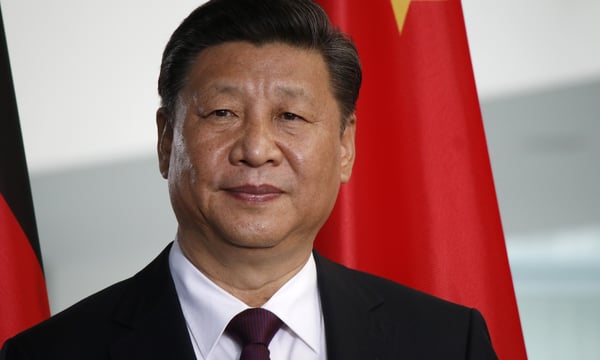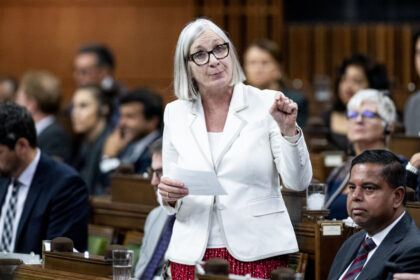In July 2025, Chinese President Xi Jinping was conspicuously absent from the BRICS summit for the first time in over a decade. At around the same time, senior Chinese Communist Party (CCP) leaders gathered in Beijing to commemorate the start of the Second Sino-Japanese War. Xi didn’t join them. Instead, he quietly laid flowers at a separate memorial, alone. The contrast was striking: Xi seemed sidelined from the very same pageantry that elevated him to the core of the CCP.
This is not an isolated event. Recently, a series of unusual developments have raised questions among China watchers: Is Xi Jinping still firmly in control of the CCP, or is an internal contest for power breaking out into the open?
While it is impossible to know for certain – the CCP’s internal politics remain notoriously opaque – several notable indicators point to internal shifts within the party.
Indicators of Power Rebalancing
The most telling signs of a power shift have come from an unprecedented sequence of purges in the People’s Liberation Army (PLA). Since 2023, the PLA has undergone three major “anti-corruption” purges that sequentially dismantled Xi Jinping’s two main sources of authority within the PLA: the Shaanxi Gang and the Fujian Clique. These factions are informal groups that have emerged during Xi’s time in each province, comprising officers and civilians connected by shared backgrounds and CCP patronage.
The first wave of purges, beginning in 2023, targeted the PLA Rocket Force (PLARF), the Central Military Commission’s (CMC) Equipment Development Department, and the Chinese military-industrial complex. Many officers purged in this wave were associated with the Shaanxi Gang, generals with connections to Xi through his home province and shared links to other “princelings.” Most prominent in this group is Zhang Youxia, the current CMC vice chair, who shares both provincial ties and family connections with the Xi clan dating back to the civil war era.
As the first wave progressed, in several instances, Xi subsequently promoted members of the Fujian Clique into positions previously held by Shaanxi Gang affiliates, possibly indicating his trust in the faction. The Fujian Clique consists of senior officials who built their careers alongside Xi’s during his time as a provincial official in Fujian. This first wave of purges likely indicated Xi’s loss of trust in officers affiliated with the Shaanxi Gang. Zhang Youxia remained untouched by the purges, but his network was weakened substantially.
In late 2024, a second wave of corruption purges turned on the Fujian Clique officers, sidelining key CMC figures such as Vice Chair He Weidong and Director of the Political Work Department Admiral Miao Hua. This second wave of purges predominantly targeted the People’s Liberation Army Navy (PLAN), alongside the broader Fujian Clique. This round of purges dismantled the networks that served as Xi’s personal foundation of loyalty in the PLA, raising questions as to who spearheaded the purges.
A third wave of purges, affecting the PLA’s internal security, anti-corruption, and logistical sectors, came in the fall of 2025. In September 2025, four more generals were expelled from the National People’s Congress. The most senior officer was Wang Chunning, the commander of the People’s Armed Police (PAP) and a Xi loyalist. This group also included Rocket Force disciplinary chief Wang Zhibin, CMC Logistics Support Department Head Zhang Lin, and Joint Logistics Support Force political commissar Gao Daguang. The affected institutions all underpin the PLA’s wartime command and domestic sustainment capabilities. The mix of officers involved – both Xi loyalists and those without known ties to China’s top leader – possibly indicates that the campaign had broadened beyond factional politics into a comprehensive loyalty audit of the command and control structure of the PLA.
On October 17, 2025, the Ministry of National Defense formally confirmed the expulsion of He Weidong, Miao, Hua, and seven other generals in a rare public disclosure days before the CCP’s Fourth Plenum. It must be noted that only four of the seven CMC members elected in 2022 remain. Turnover of this magnitude has not been seen in decades.
These three waves of purges can be interpreted through several distinct yet overlapping narratives.
1. Xi’s Deliberate Consolidation: This narrative presents Xi as intentionally removing corrupt, politically unreliable, or dissenting officers. His objective is to create an ideologically cohesive, smaller elite officer core within the PLA. The purging campaign is an extension of Xi’s campaign to purify the military and ensure Party control.
2. Hijacked Purge: In this narrative, Xi initially launched the anti-corruption campaign but lost control of it as other CCP and CMC elites – likely Vice Chair Zhang Youxia and remnants of the Shaanxi Gang – redirected the purge to protect their own networks or reshape the officer core to fit their interests. The removal of Xi-aligned generals affiliated with the Fujian Clique may represent a counter-balancing effort within the PLA elite.
3. Temporary Power Loss & Retrenchment: In this scenario, Xi briefly lost influence over the purge mechanism from mid-2024 to early-2025, when the campaign turned against his Fujian clique allies. In this narrative, Xi reasserted control prior to the 2025 Victory Day parade in early September. The purges became technical, not political in nature, and subsequently were formalized prior to the Fourth Plenum to demonstrate renewed control.
4. Party Reassertion: In this narrative, the purges are not purely factional at all. Instead, they are an institutional correction to curb the over-centralization of the command and control apparatus on Xi. The reemergence of “collective leadership” and “democratic centralism” in PLA Daily articles supports the idea that the CCP is reasserting traditional mechanisms that facilitate collective decision-making control.
We cannot draw definitive conclusions yet, but what is clear is that the PLA purges have evolved from targeted anti-corruption removals in wave one to a comprehensive political recalibration of the PLA’s military command structure in wave two. It is unclear whether this process reflects Xi’s deliberate consolidation, an internal power struggle, or a collective attempt to stabilize the CCP apparatus ahead of a future crisis contingency, perhaps in the Taiwan Strait. Regardless, the outcome is the same – the purges have damaged the networks that provided Xi with power over the PLA.
Simultaneous to the PLA purges, several PLA Daily articles, written by academics tied to Zhang, have subtly promoted “collective leadership” and “democratic centralism” – rhetoric that runs counter to Xi’s unified control. What is more, these articles openly, if implicitly, contradicted an article published by Xi Jinping in Qiushi, the CCP’s flagship ideological journal, in December 2024, reaffirming the need for centralized, unified control of the CCP’s leadership apparatus. In speeches to PLA soldiers, Zhang Youxia has emphasized the need to ensure obedience to party directives and loyalty to the CCP, but notably failed to equate the party’s will with Xi’s.
Indicators of Xi’s potentially contested power are not limited to the PLA. On June 30, 2025, the CCP introduced regulations requiring Politburo-led Leading Small Groups (LSGs) and central commissions to submit decisions to the Central Committee for approval. This procedural shift directly constrains the informal decision-making apparatus Xi has used to centralize his control. While framed as institutional refinement, the move effectively reasserts party-wide oversight of Xi’s unified leadership.
Furthermore, CCP officials loyal to Xi have been transferred from critical roles in the CCP’s bureaucracy and replaced with non-aligned figures. Li Ganjie, a Politburo member with clear ties to Xi, previously led the CCP’s powerful Organization Department. In April 2025, Li swapped jobs with Shi Taifeng, another Politburo member with no overt ties to Xi’s inner circle and distant but notable connections to former leader Hu Jintao. Shi served as the chief of the United Front Work Department (UFWD) prior to the swap. Subsequently, Shi assumed Li’s position as head of the Organization Department, and Li assumed Shi’s role as chief of the UFWD.
It is not surprising that Xi would want a loyalist at UFWD, given that he has prioritized united front work. But the loss of a loyalist at the Organization Department, which is responsible for cadre elevation and political appointments, raises questions about Xi’s grip on all of the CCP’s levers of control.
Historical Echoes: Hua Guofeng’s Gradual Sidelining
Throughout the CCP’s history, leadership transitions have often begun behind closed doors. Of the CCP’s past leadership transitions, the most analogous case to the present-day situation – assuming, for the moment, that a transition is now underway, which is still unclear – is that of Hua Guofeng’s replacement by Deng Xiaoping in the late 1970s and early 1980s. Like Xi, Hua inherited power through a blend of institutional appointment and personal endorsement and rose through rapid consolidation and centralization of power.
But over time, CCP elders rallied behind Deng Xiaoping, who had returned from political exile in 1977 and steadily built his influence. Deng’s policy agenda sidelined Hua’s at the Third Plenum of the 11th Central Committee in 1978, with the CCP clearly pivoting away from Hua’s ideology. Rather than removing Hua, Deng slowly promoted his allies into key positions in party organization, economics, and propaganda, while encouraging criticism of power centralization in official discourse. By 1980, Hua had lost the premiership, retained only the party chairman title, and was excluded from policymaking. The chairman position itself was subsequently abolished in 1982, ending his influence entirely.
Xi may now face analogous pressures. The June 2025 CCP regulations – requiring LSGs and commissions to report to the Central Committee – mirror the institutional reassertion of the Hua-Deng leadership transition, curbing XI’s informal decision-making apparatus. PLA “anti-corruption” purges may have weakened Xi’s lines of power to the PLA, while PLA media has subtly challenged Xi’s rhetoric on centralized leadership.
However, unlike Hua, Xi’s media presence has not diminished; Xi has retained dominance in the state-run media space. Furthermore, Xi continues to appear at the center of domestic orchestrated displays of power, such as the recent PLA parade, suggesting a Xi retrenchment is more likely than his quiet displacement. And while Xi has been notably absent at multiple major diplomatic forums, such as the 2025 BRICS Summit and 80th United Nations General Assembly meeting, he did attend the APEC Summit in South Korea and met with U.S. President Donald Trump in late October.
Possible Paths Forward and Indicators to Monitor
From here, several outcomes are possible. Xi could keep his titles as his power wanes, while others increasingly shape CCP leadership decisions behind the scenes. Alternatively, Xi may agree to a facilitated leadership transition, giving space for a new figure to emerge while avoiding confrontation. Another possibility is that Xi may remain at the center but accept a more balanced arrangement, sharing authority distributed among senior leaders of various factions. Lastly, Xi could move to retrench his leadership by reasserting his control through loyalty purges, removing his potential rivals, and tightening his grip on key institutions. Considering the recent orchestrated displays of strength, such as the September PLA parade, where Xi played a central role, it is possible that he is actively attempting to reassert his authority, despite potential turmoil under the surface.
As certain indicators come to light over the coming months, the path forward will take shape. Most notably, observers should watch for the rise of a clear successor to Xi Jinping. The presence of a collectively elevated successor, potentially appointed to the Politburo or another key CCP role, would indicate a potential leadership transition. Furthermore, changes in leadership within the PLA, Politburo Standing Committee, and other party leadership posts could indicate whether a specific faction is consolidating control. Any further procedural rules limiting informal decision-making would signal a deeper, structural shift away from Xi’s unified leadership.
Ultimately, none of these developments confirm Xi Jinping’s imminent departure. Taken together, however, they indicate the first sustained signs in over a decade that the CCP may be recalibrating away from personalized, one-man rule. In a system where political shifts often unfold quietly and incrementally, these indicators are worth tracking for the long-term implications they carry for China’s domestic governance and foreign policy trajectory.






